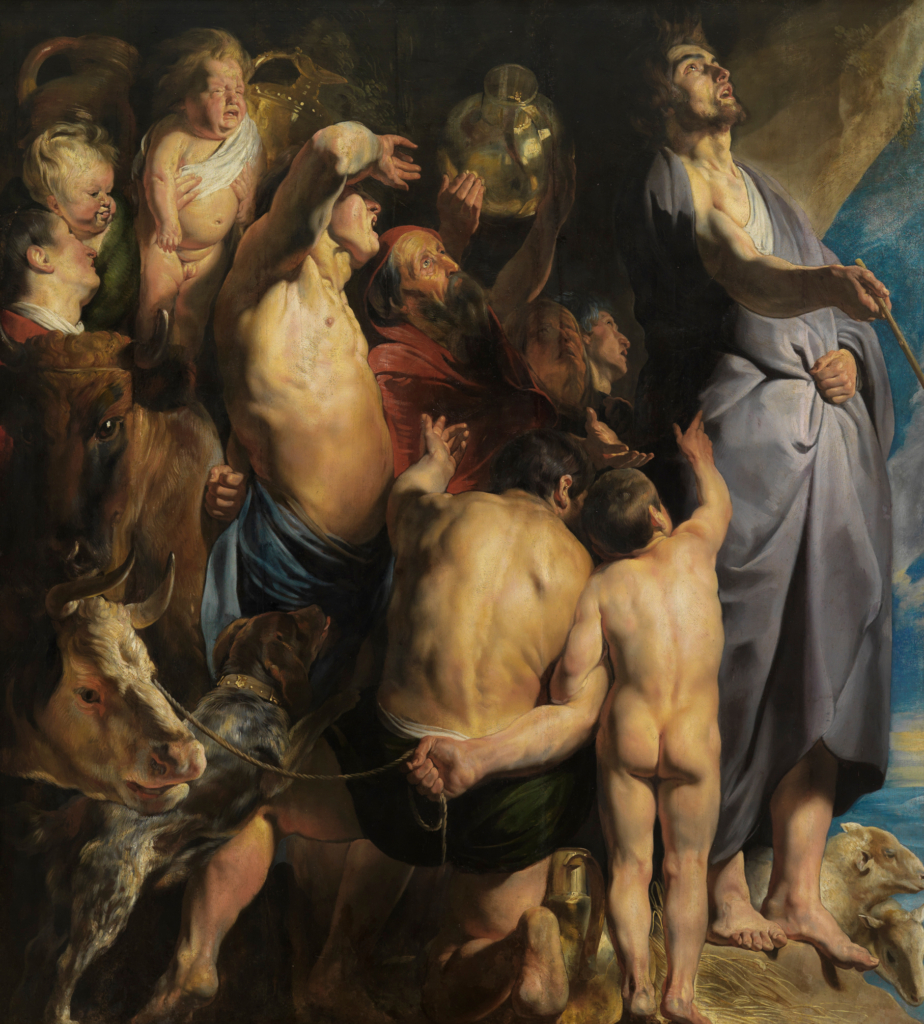
| X (Twitter) | |
|---|---|
URL kopieren
Die URL wurde erfolgreich kopiert und befindet sich in der Zwischenablage |
|
Aus urheberrechtlichen Gründen können wir die Werkabbildung leider nicht zum Download bereitstellen.
Hier erfahren Sie mehr.Moses Striking Water from the Rock
Jacob Jordaens (1593)
H 180cm W 200cm
around 1618
KunsthalleKarlsruhe@ZKM
Description
Bathed in bright sunlight, people’s bodies are crowded close together. The tension is palpable: from infants to the old, the thirsty, this seething mass of people seems frozen in anticipation. Every fibre betrays the moment of holding one’s breath. Unlike in centuries before, Jordaens, one of the most important Flemish painters of his time, does not depict several moments of this story simultaneously: the Old Testament miracle of water issuing from the rock. Jordaens boldly concentrates, with Baroque vehemence, on the dramatic seconds before the miracle occurs.
500 years of the presence
0:00
0:00
Soldier and art lover
Widely travelled, active as a soldier and diplomat, Margrave Hermann of Baden-Baden rendered many services to the Holy Roman Empire as the Emperor’s general and envoy beginning in the 1660s. He had originally been destined for an ecclesiastical career and for a time was considered a possible successor of the Polish king. If one retraces the countless assignments he executed throughout Europe, one wonders how he found the leisure to supervise the furnishing of his Regensburg residence. However, the inventory of his estate of 1691 demonstrates he was obviously a passionate lover of art.
Highly modern: A collection solely of pictures
It should be emphasised that Margrave Hermann’s collection was not characterised by any concentration on the many of wonders created by nature and man, which was still a common feature in many places at that time. Instead, the inventory lists an immense number of paintings that certainly adorned not only the living and working rooms of the ruler, but probably a separate collection room as well.
With this collection of just paintings — a phenomenon that only emerged in the Netherlands in the 17th century — Hermann shows himself to be entirely abreast with contemporary developments. But first and foremost he distinguishes himself by his appreciation of contemporary German and especially Dutch art production.
Art in large formats
First and foremost, the worldly bachelor was interested in the epitome of Baroque painting, the Flemish art of the first half of the 17th century: Rubens, Rubens, Snyders, Rubens, and Jordaens. However, of the 20 works still on display in the Kunsthalle today, the Dutch masterpieces of, for example, Pieter Coecke van Aelst or Jan Davidsz. de Heem should not be overlooked. In Hermann’s inventory, much more frequent than a “stuckhel” or “stücklein” (small, easily affordable and easily transportable cabinet pieces), the term “ein gross stuckh (a large piece)” is found. The large formats were usually of mythological or biblical themes, as in the case of this painting of Moses and the Miracle of the Spring, which certainly was appropriate for a Catholic ruler like Hermann. The artist Jacob Jordaens, who was just 25 years old when he painted this picture, dramatically depicted with Baroque concentration and force the moment when a divine miracle saves the thirsty Israelites.
Contemporaries from two different generations
The large workshop that Jordaens later ran in Antwerp testifies to the changing nature of commissioned works during this golden age of Dutch art: It was not only orders from the church and the state that secured Jordaens his considerable income, but also the works ordered by numerous international rulers and royal families.
However, this painting, of which nothing is known about its original context of creation, is unlikely to have passed directly from Jordaens to Hermann, even though the two men lived as contemporaries for at least 50 years. Rather, it is the interesting constellation that a mature art collector in Baden who, at a time when Baroque Flemish art was at its zenith, took an early work by one of its main representatives into his princely collection.
Dates and facts
| Title | Moses Striking Water from the Rock |
|---|---|
| Artist | Jacob Jordaens (1593) |
| Date | around 1618 |
| Measurements Painting | H 200cm W 180cm |
| Material | Oil on oak wood |